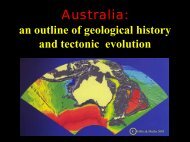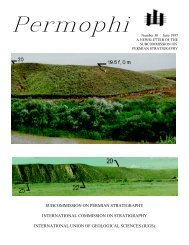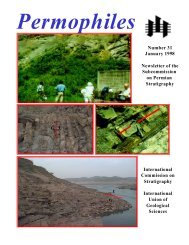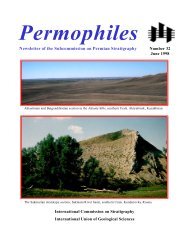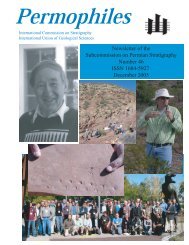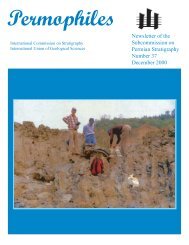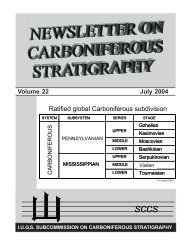Permophiles
Permophiles
Permophiles
You also want an ePaper? Increase the reach of your titles
YUMPU automatically turns print PDFs into web optimized ePapers that Google loves.
Volcanic ashes in the Upper Paleozoic of the southernUrals: Their biostratigraphic contstraints andpotential for radiometric datingDavydov, V.I.Department of Geosciences, Boise State University, 1910 UniversityDr., Boise, ID, 83706 vdavydov@boisestate.eduChernykh, V.V.Laboratory of Stratigraphy and Paleontology, Institute of Geologyand Geoshemistry, Uralian Scientific Center of Russian Academyof Sciences, Pochtovy Per. 7, Ekaterinburg, Russia, 620219,Chuvashov, B.I.Laboratory of Stratigraphy and Paleontology, Institute of Geologyand Geoshemistry, Uralian Scientific Center of Russian Academyof Sciences, Pochtovy Per. 7, Ekaterinburg, Russia, 620219Northrup, C.J.Department of Geosciences, Boise State University, 1910 UniversityDr., Boise, ID, 83706 northcj@boisestate.eduSchiappa, T.A.Department of Geosciences, Boise State University, 1910 UniversityDr., Boise, ID, 83706Snyder, W.S.Department of Geosciences, Boise State University, 1910 UniversityDr., Boise, ID, 83706 wsnyder@boisestate.edu<strong>Permophiles</strong> Issue #39 200113Numerous volcanic ash layers with numerous clear, multifacetedzircons of high optical quality occur within the upper Pennsylvanianand Cisuralian successions of the southern Urals, andmost of these ash layers contain abundant radiolaria and wellpreservedconodonts. Such ashes have been used routinely elsewherefor radiometric age control, but rarely studied from a paleontologicperspective. Paleontologic investigations have seldom focusedon volcanic ashes because: 1) they are a relatively minorcomponent in most stratigraphic sections; and 2) techniques forrecovery of micropaleontologic objects from ashes are not wellestablished. Nevertheless, the potential to obtain detailed paleontologicdata and precise absolute age control from the same stratigraphichorizon can provide a powerful tool for understandingprocess rates in paleobiology, paleoecology, sedimentology andin the rest of geological disciplines.The study of zircons from the Late Pennsylvanian throughearly Permian at the stage/substage level using the type sectionsand principal reference sections in the foreland of the southernUrals in Russia-Kazakhstan offers an unparalleled opportunity foraccurate and precise time scale calibration for several reasons.First, the southern Urals contain the Global Stratotype Sectionand Point (GSSP) for the base of the Permian and this region is acandidate for the GSSP for the Cisuralian and Pennsylvanian stagesas well. Regardless of the final outcome of the Pennsylvanian GSSPstage designations, the Russian sections will, at minimum, be criticalreference sections for global correlation. Thus, the internationallyaccepted biostratigraphic definition of the Pennsylvanianthrough Cisuralian (Early Permian) time scale is linked directly tothe southern Urals. Second, marine fossils are numerous and wellpreserved in this region, making detailed multitaxa biostratigraphiccontrol possible. Finally, the late Paleozoic sections of the southernUrals contain numerous interstratified volcanic ash layers,making precise radiometric age control possible. Here, we documentthe occurrence of conodonts and radiolaria in upper Paleozoicvolcanic ash layers of the southern Ural foreland and brieflydescribe techniques developed to recover these microfossils fromvolcanic matrix.Principal tectonic elements within the region are illustrated inFigure 1A, and include: the European continent, consisting of theBaltic Shield, Russian Platform, Timan-Pechora region, Kama-Kineland Pre-Caspian basins; Uralian Orogenic Belt (including the Pre-Uralian Foredeep); Ustyurt Microcontinent (a paleoTethyan terrane),and the Kazakhstan and Siberian continents. Historically,the Uralian system has been divided into several major faultboundedlongitudinal belts, or megazones. This longitudinal tectoniczonation has been reinterpreted recently to reflect modernterminology (Brown et al., 1996). From east to west, the megazonesare now regarded as (Figure 1B): accreted arcs and microcontinentsincluding (1) Eastern Uralian Microcontinents, and (2) Tagil-Magnitogorsk Arc; (3) orogenic hinterland (Ural Tau; (4) theSakmara, and Kraka nappes; foreland fold-thrust belt, including (5)Bashkirian Precamrian basement,); (6) Ordovician-middle Devonianshelf succession; (7) Zilair Series (late Devonian-Mississippianbasinal succession); and (8) foredeep basin; and (9) undisturbedRussian Platform.The Pre-Uralian Foredeep (Figures 1B, 2) was initiated duringthe Middle Carboniferous, and formed in response to a series ofcollisions along the eastern margin of the European continent.Collision and accretion involved a combination of arc terranes,and continental fragments (the Tagil-Magnitogorsk Arc, Ural Tau,and Eastern Uralian microcontinent). Overthrusting of the EastEuropean continent margin by the tectonic elements of the UralianHighlands is presumed to have produced a flexural load that createda classic foreland basin, the Pre-Uralian Foredeep. Uralianorogenesis concluded with the collision and suturing of theKazakhstan and Siberian continents to the EC in Late Permian-Middle Triassic time (Zonenshain et al., 1990; Snyder et al., 1994).Overall, the Late Carboniferous-Early Permian foredeep shallowedeastward and deepened westward and was broken up into a seriesof sub-basins (Figure 1B; Snyder et al., 1994). Two sub-basinswithin the southern foredeep have been delineated: the northernUral ( or Uralo-Ikskaya) basin, and the southern Aqtöbe (orAktyubinsk) basin (e.g., Ruzhencev, 1951; Khvorova, 1961;Chuvashov,1993; Snyder et al., 1994). Geophysic data and facieschanges suggest the boundary between these two sub-basins mostprobably are structural (Melamud, 1981). The uppermost Carboniferousthrough Cisuralian strata of the Aqtöbe sub-basin are predominantlyclastic, consisting of micritic siltstone, fine to coarseallochemic sandstone, and conglomerate units (Khvorova, 1961;Snyder et al., 1994). Correlative units in the Ural sub-basin includepredominantly carbonate dominated strata, consisting of siltymicrites, allochemic wackestone-packstone-grainstone packages,floatstone and rudstone. Abundant fossil faunas are present inthe wackestone-packstone-grainstone packages (Figure 2). Thesouthern Pre-Uralian Foredeep is bounded to the north by the



